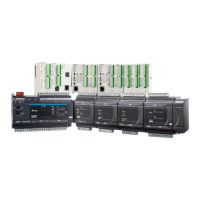Chapter 10 CANopen Function and Operation
5. It supports the reading emergencies from a slave service.
Use this service to read an error or an alarm from a slave.
You can store up to 5 emergencies in a slave.
You can read emergencies from a slave through a PLC ladder diagram.
6. It supports the SYNC object (synchronous object) service.
7. Several devices can operate synchronously through the synchronous object service.
8. The supported CANopen communication rates are: 20K, 50K, 125K, 250K, 500K, and 1Mbps.
The supported mapping data types are:
32-bit DINT UDINT REAL DWORD
64-bit LINT ULINT LREAL LWORD
The CAN port has the following functions when acting as a slave.
It supports the standard CANopen protocol DS301 V4.02.
It supports the NMT (network management object) service.
It supports the NMT state control.
The state of the DVP-ES3/EX3/SV3/SX3 Series in the CANopen network is controlled by a
master.
It supports the NMT error control.
The DVP-ES3/EX3/SV3/SX3 Series supports Heartbeat but not Node Guarding.
It supports the PDO (process data object) service.
The PDO message transmits the immediate input data and output data.
It supports up to 8 TxPDO and 8 RxPDO.
The PDO transmission type: synchronous mode and asynchronous mode
It supports the emergency service.
If an error or an alarm occurs in the DVP-ES3/EX3/SV3/SX3 series, the master is notified through the
emergency service.
10.1.2 The Input/Output Mapping Areas
The following table lists the CANopen DS301 specifications for the AS DVP-ES3/EX3/SV3/SX3 Series PLC.
Master
Maximum transfer size of
Up to 2000 Bytes (including some system configurations)
Slave
Maximum transfer size of
Up to 8 PDOs; each PDO with up to 8 bytes can be transferred

